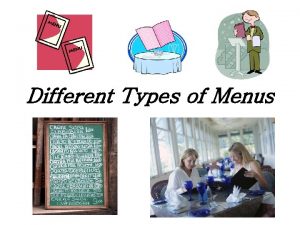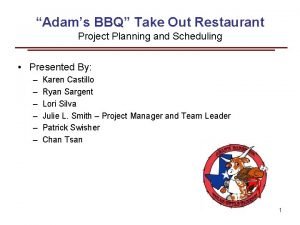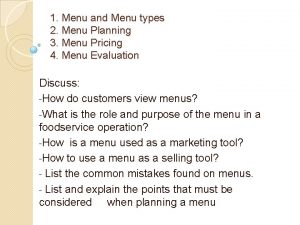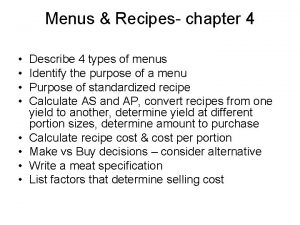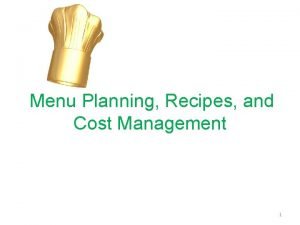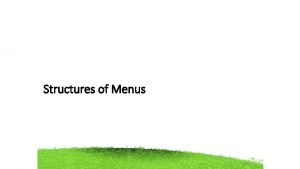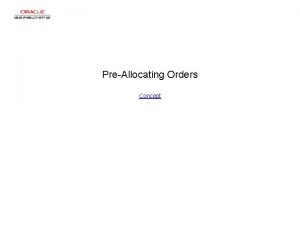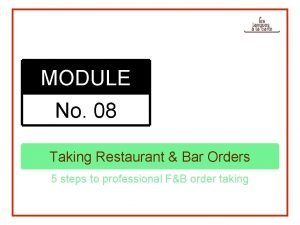Restaurant Menus and Taking Orders Different Types of










- Slides: 10

Restaurant Menus and Taking Orders

Different Types of Menu -A la carte menu… • The four types of menus most commonly used are a la carte menus, static menus, du jour menus, and cycle menus. • An a la carte menu lists the prices for each item separately. While the prices tend to be higher, a la carte menus have more flexibility. Customers can choose individual items and combine them any way they want. A la carte is a French phrase that translates literally as “by the card” and roughly as “according to the menu. ” It began being used in the early 19 th century and is not exclusive to food. For example, a subscription to a cable provider can have a la carte channel selection. That means customers choose which channels they want individually instead of having a set channel package. Phrases like “from the menu” and “individually priced” communicate that a menu or section of a menu is a la carte. https: //home. binwise. com/blog/types-of-menu

Static / Du Jour / Cycle Menus • A static menu is the most widely used menu today. A static menu doesn’t change often. Food and beverage are categorized into different groups. For food this may be appetizers, salads, entrees, etc. For drinks it may be shots, cocktails, beer, and wine. • Du jour menus change daily, depending on what’s available or what the chef prepared. So, “chicken du jour” means the chicken that’s available today. Likewise, “soup du jour” is the soup that’s available today. Du jour is a French phrase that means “of the day’’. • A cycle menu is a menu or part of a menu that has repeated options over a specific period of time. Think of a sandwich shop that offers a certain sandwich on Monday. Then another sandwich on Tuesday. And so on for the rest of the week. If they repeat those same offerings on those same days, it’s a cycle menu!

Beverage / Cocktail / Dessert Menus • A beverage menu is any menu or section of a menu that sells alcoholic and non-alcoholic drinks. It can be a static, du jour, or cycle menu. Beverage menus are typically not a la carte menus. • A cocktail menu is a specific type of beverage menu or section of a beverage menu. A good cocktail menu has a mix of base liquors, glassware, and flavors. It should also have one or two seasonal cocktails. Like beverage menus, it can be a static, du jour, or cycle menu and not a la carte. • Typically viewed at the end of a meal, a dessert menu is a menu or section of a menu that lists only the desserts. It can be an a la carte, static, du jour, or cycle menu. •

Full Course Meals • A full course dinner is a meal featuring multiple courses. The basic full course meal consists of three or four courses. Full course meals normally begin with precursors to a main dish, such as an amuse-bouche or soup, followed by the main course(s), and they are finished off with sweets, coffee, and tea. • A meal course is a single food item or a set of food items served at once, such as a sandwich, soup and crackers, or steak and mashed potatoes. An average meal consists of one or more meal courses. • Many meals only contain one course. The most basic full course meal is made up of 2 or 3 of the following courses: an appetizer, a main dish(or entrée) and a dessert. However, meals can feature up to 12 or more courses. • A common and logical way for your full course meal to proceed is by starting with light plates, continuing with richer dishes, and finishing off with small and delicate items.

Sample Meal Courses • A 12 course dinner menu includes an hors d'oeuvre, amuse-bouche, soup, appetizer, salad, fish, first main course, palate cleanser, second main course, cheese course, dessert, and mignardise. • Course One - Hors d'oeuvres. Since this course is typically served during a cocktail hour or as guests are arriving, hors d’oeuvres are usually finger-foods that can be held in the hand. • Goat cheese crostini with fig-olive tapenade • Zucchini fritters • Shallot and pancetta tortilla crisps • Course Two - Amuse-bouche. This can be translated from French to mean “amuse the mouth” or more generally, to please guests’ palates with a small flavorful taste. Frequently, this might serve to stimulate the appetite or simply hint at flavors to come in the next meal course(s). In restaurants, this is normally a complementary item specifically chosen by the chef. • Sweet potato chips with goat cheese and caviar • Caprese bites with basil vinaigrette • Pea soup served in a shot glass or espresso cup • Course Three - Soup. As with all of your courses, a classic idea is to relate your soup course to the season. It's always smart to avoid soups that are too hearty so guests don’t fill up for the rest of the meal. • Cold melon and basil soup • Pumpkin sage bisque https: //www. webstaurantstore. com/blog/2578/full-course-meal. html

Course Four – Appetizer. In many parts of Europe, this course is referred to as the "entree" because it introduces the main courses in the meal. It is usually served on serving trays or small appetizer plates and features small cuts of meat, seasonal vegetables, starches, and sauces. Charred broccoli with shishito peppers and pickled onions Mushrooms stuffed with Pecorino Romano, garlic, and bread crumbs Candied carrots with honey, cumin, and paprika Course Five - Salad. This course is usually an assortment of raw vegetables with a flavorful dressing. In some parts of Europe, salad is served after the main course, but it is also common to serve salad before. Garden salad with lettuce, tomatoes, onions, and tart vinaigrette Chopped Thai salad with peanut dressing Greek salad with olives, lettuce, red onions, and feta cheese Course Six – Fish. This dish is a flavorful light protein before the main courses. Grilled salmon with a soy sauce marinade Lemon garlic tilapia Crispy trout with a parsley-caper vinaigrette Course Seven – First main course. The first main dish is often a white meat, such as chicken, duck, or turkey. Spicy Thai basil chicken Roasted duck with an orange-ginger glaze Deep-fried turkey with a honey bourbon glaze Course Eight – Palate Cleanser. This is like a reset for your taste buds. Its purpose is to remove residual tastes from the mouth before the next course. Sorbet (lemon, melon, or mint) Prosecco Water with lemon https: //www. webstaurantstore. com/blog/2578/full-course-meal. html

Course Nine - Second main course. Typically, the second main course is a red meat, such as premium beef, lamb, or venison. Stuffed lamb breast with lemon, ricotta, and oregano Grilled flatiron steak with rosemary potatoes Herb-crusted venison medallions Course Ten - Cheese course. Create a platter of different cheeses along with items to accompany them. Include a variety of cheese textures and flavors, such as aged, soft, firm, and blue cheeses Choose a selection of breads and crackers Provide companion items, such as jams, chutneys, spicy mustards, caramelized onions, candied nuts and pistachios Course Eleven - Dessert. Usually accompanied by a glass of dessert wine or coffee and tea, this is a sweet and decadent course. Rich flourless chocolate cake with a glass of sweet port wine Lemon creme brulee with dry white wine Fruit tarts and berries with champagne Course Twelve – Mignardise. At the end of the meal, you can serve a mignardise, which is a tiny, bitesized dessert or pastry served with tea, coffee, port, brandy, or scotch. Miniature butter madeleine biscuits Small pieces of chocolate Bite-sized macarons https: //www. webstaurantstore. com/blog/2578/full-course-meal. html

Tips for Serving a Full Course Meal The way you serve or enjoy a full course meal is up to your discretion and can be as casual or formal as you prefer. Below are some tips to curate a full course meal along with information on traditional etiquette. Ø Provide a goblet of water and a glass of wine for each guest. Ø Each course requires its own dinnerware and silverware, so set your table based on the number of courses in your meal. Ø Guests will first use the outermost utensils and work their way in towards the plate as the courses progress. Ø Remove each course plate before bringing out the next course. Ø Don’t wait too long between serving each course. Ø Traditional etiquette says that each plate should be cleared (from the right side of each guest) before serving another (to the left side of each guest). Ø If you do not have servers at your dinner party, have guests pass the dishes from the left, so they can easily serve themselves, since most people are right-handed. Ø Many table settings will have a charger plate that serves as a base setting on top of which dinnerware for each course is placed. The plate is only cleared when dessert is served. Ultimately, you can serve a meal as creatively or traditionally as you'd like. You can include as little as one course and up to as many as you have time and energy for. Full course meals provide ample opportunity for hosts, chefs, and restaurants alike to show off their talents and tastes while offering an enjoyable and decadent dining experience that guests will remember. • https: //www. webstaurantstore. com/blog/2578/full-course-meal. html

Appetizers § Dolmas (stuffed vegetable) § Greek Pan Seared Cheese (Saganaki) § Greek Cabbage Rolls (Lahanodolmathes) (Cabbage leaves stuffed with meat and rice and served with an egg-lemon sauce) § Feta Cheese with Honey § Marinated Greek Olives § Fried Anchovies (Gavros) § smoked trout § Piroski § Pepper Salad § Lenten Fish Roe Salad (Taramosalata) § Peppered Dried Figs § Cheese Balls § Grilled haloumi cheese • https: //www. 50 languages. com/vocab/learn/el/en/20/ • https: //www. greekboston. com/category/food/appetizers/
 The type of menu that offers the same dishes everyday is
The type of menu that offers the same dishes everyday is Casey orders 3 pizzas and 2 orders of breadsticks
Casey orders 3 pizzas and 2 orders of breadsticks Casey orders 3 pizzas and 2 orders of breadsticks
Casey orders 3 pizzas and 2 orders of breadsticks Casey orders 3 pizzas and 2 orders of breadsticks
Casey orders 3 pizzas and 2 orders of breadsticks Zclubus
Zclubus Project charter of a restaurant
Project charter of a restaurant Elements of wimp
Elements of wimp Types of menu planning
Types of menu planning What are the four types of menus
What are the four types of menus Menus recipes and cost management
Menus recipes and cost management Palettes and tear-off menus
Palettes and tear-off menus
